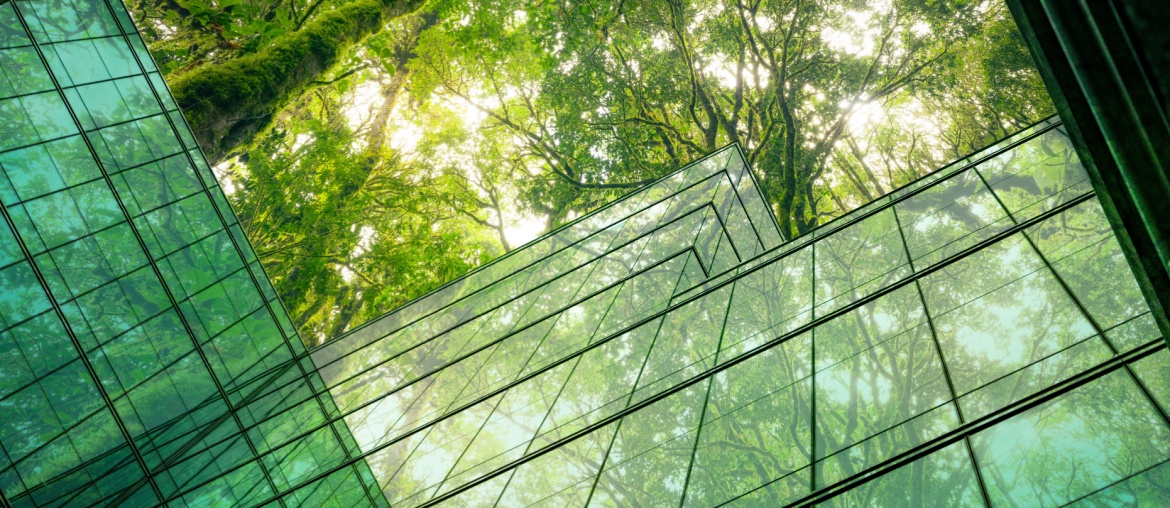As cities around the world grapple with the challenges of rapid urbanization and climate change, the push to become greener has increased for cities everywhere. In fact, citizens are increasingly shifting their priorities with 52% of Americans now valuing environmental protection over economic growth, which is prompting decision-makers to focus on creating cities that breathe and thrive sustainably.
So, to pinpoint the U.S. cities that took the most steps toward greener, cleaner living, we looked at 12 key sustainability metrics, including air quality, green energy and buildings. By aggregating these metrics, we developed the CoworkingCafe Sustainability Index (CSI) to rank 2024’s leading U.S. green cities.
California Shines Green: San Francisco Tops List as 4 Other California Cities Make Top 10 Eco-Friendly Rankings
When it comes to sustainability efforts across the U.S., the West Coast and Northeastern regions dominate the green city landscape. California emerges as a national leader, with five cities making the top 10 — including San Francisco, Los Angeles, and San Diego. The state’s strong environmental policies, and access to renewable energy resources, such as solar and wind, play a crucial role in driving its cities toward greener living.
Meanwhile, the Northeast, led by cities like Washington, D.C., and New York City, stands out due to dense urban planning that supports efficient public transit systems, green buildings, and widespread recycling initiatives.
1. San Francisco, CA – 62.5 points
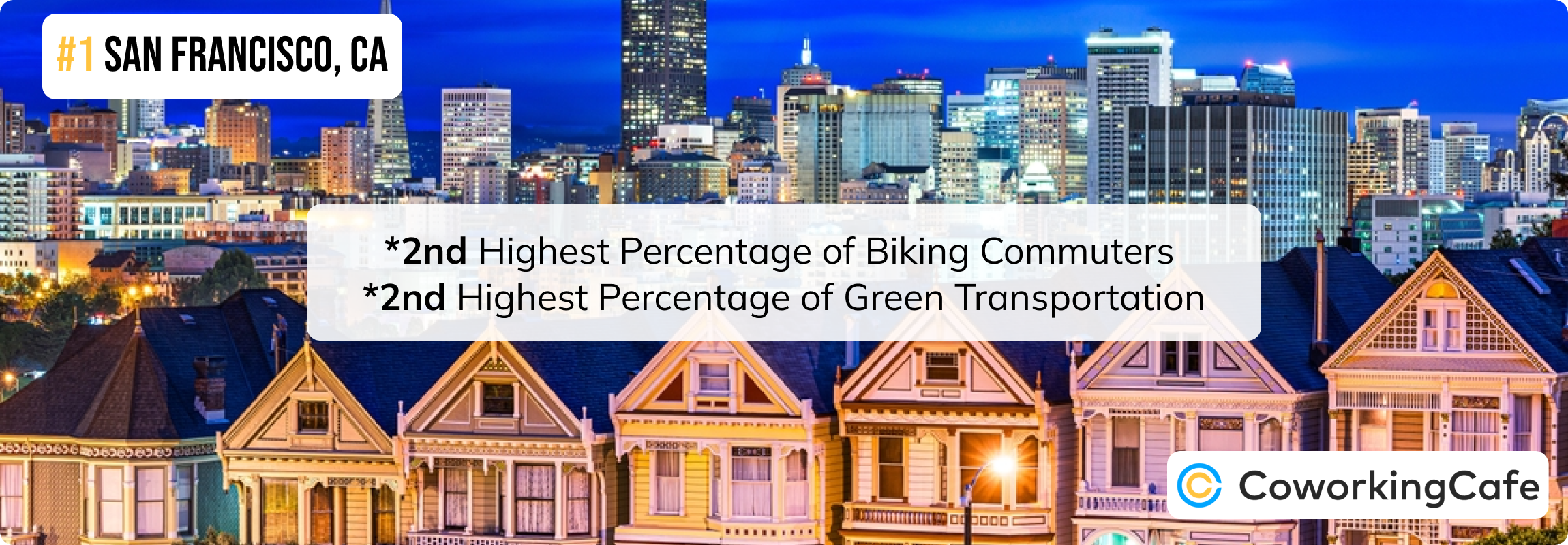 San Francisco holds a CSI score of 62.5 points, making it this year’s eco all-star. Despite being the birthplace of ridesharing startups like Lyft and Uber, public transportation is still a popular option among the city’s residents. To that end, a whopping 23.9% of San Franciscans prefer to commute this way to work, while another 3.4% choose biking. Accordingly, the city is maximizing its sustainability potential in this sector with 68% of public transportation being eco-friendly. It’s also aiming for an all-electric fleet by 2040.
San Francisco holds a CSI score of 62.5 points, making it this year’s eco all-star. Despite being the birthplace of ridesharing startups like Lyft and Uber, public transportation is still a popular option among the city’s residents. To that end, a whopping 23.9% of San Franciscans prefer to commute this way to work, while another 3.4% choose biking. Accordingly, the city is maximizing its sustainability potential in this sector with 68% of public transportation being eco-friendly. It’s also aiming for an all-electric fleet by 2040.
Furthermore, when it comes to recycling, San Francisco boasts the highest percentage of households that have access to these services among the top 10 cities, with an impressive 95%. The participation rate is also notably high, with 65% of households reducing their footprint through recycling. Nevertheless, San Francisco’s #1 spot comes as no surprise as the city spearheaded environmental policies and awarded community grants to projects that support its Climate Action Plan.
2. Washington, D.C. – 56.5 points
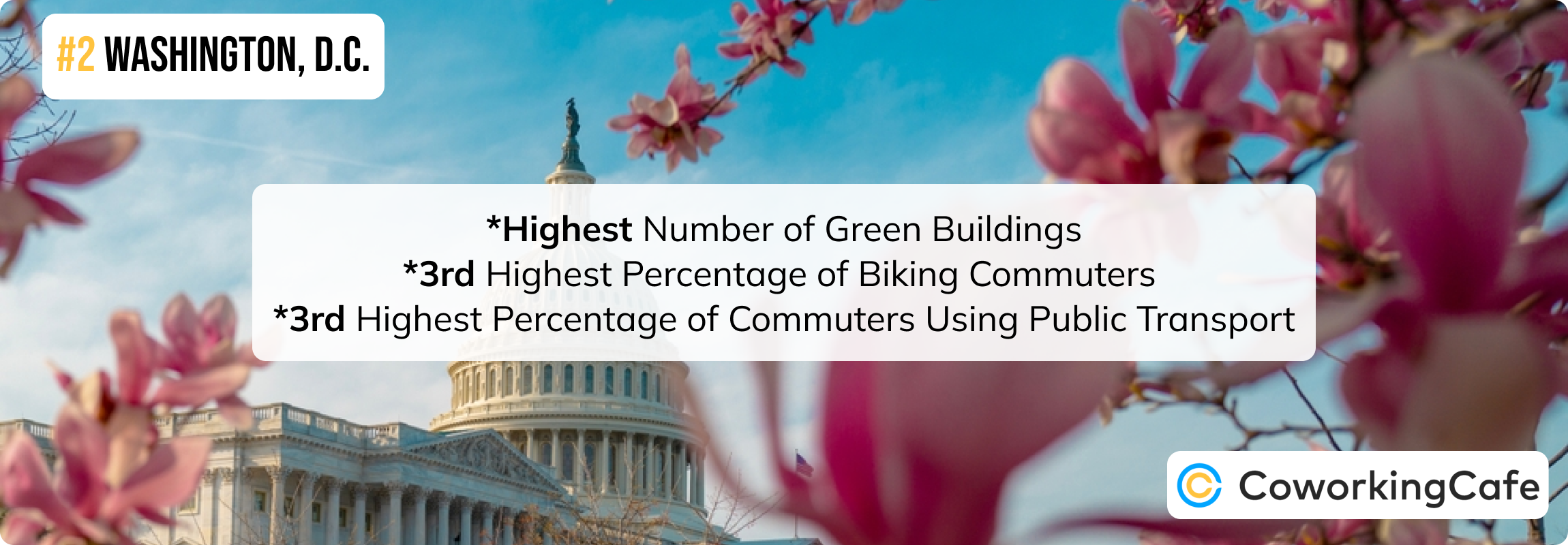 The nation’s capital is leading by example in the race for a greener city, snatching second place on our list. Notably, Washington, D.C. leads all cities analyzed in terms of the number of green buildings, totaling 1,964. And, in an effort to further spread this trend around the U.S., the federal government is electrifying all new buildings and encouraging states and cities to follow suit.
The nation’s capital is leading by example in the race for a greener city, snatching second place on our list. Notably, Washington, D.C. leads all cities analyzed in terms of the number of green buildings, totaling 1,964. And, in an effort to further spread this trend around the U.S., the federal government is electrifying all new buildings and encouraging states and cities to follow suit.
Here, the city’s extensive public transportation system also plays a key role with nearly 25% of residents relying on eco-friendly public transit options to get to work. Additionally, the city has invested heavily in urban green spaces — boasting more than 13 acres per 1,000 residents — including parks and tree canopies, which not only enhance air quality, but also provide vital cooling effects in the face of rising temperatures. Plus, with nearly universal recycling access (95% of households), D.C. has made significant strides toward waste reduction, making it a sustainability stronghold.
3. Portland, OR – 53.6 points
 Portland continues to solidify its place as a pioneer in sustainability, ranking third. The city’s transportation network is also among the greenest in the country with 30% of its public transit options being eco-friendly. At the same time, cycling is deeply embedded in Portland’s culture with 4.1% of commuters choosing to bike to work — the highest percentage nationwide.
Portland continues to solidify its place as a pioneer in sustainability, ranking third. The city’s transportation network is also among the greenest in the country with 30% of its public transit options being eco-friendly. At the same time, cycling is deeply embedded in Portland’s culture with 4.1% of commuters choosing to bike to work — the highest percentage nationwide.
Portland also stands out for its green buildings with 673 LEED-certified structures. Moreover, Portland’s access to green spaces is noteworthy with 22 acres of parkland per 1,000 residents ensuring that locals have plenty of nature nearby.
4. Los Angeles, CA – 53.4 points
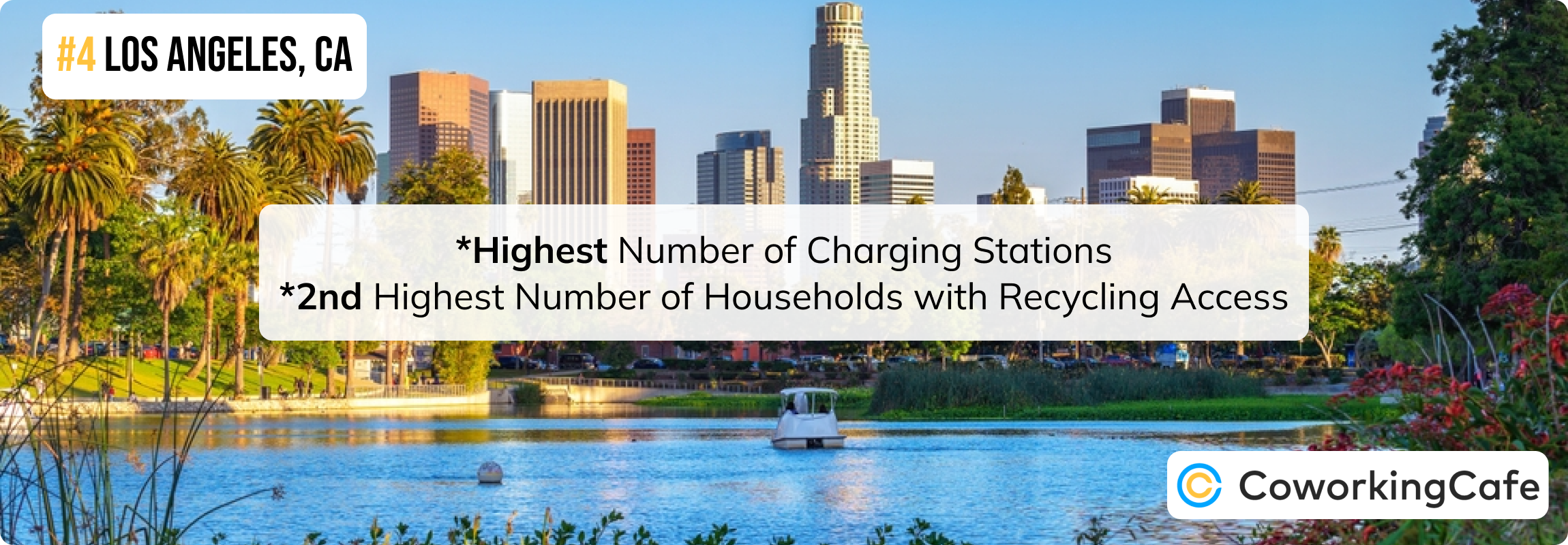 Often associated with gridlock and smog, Los Angeles is proving that a mega-city can turn the tide toward sustainability. In this case, the city’s fourth position in our ranking is boosted by the 1,605 electric vehicle charging stations available — the highest number in our analysis.
Often associated with gridlock and smog, Los Angeles is proving that a mega-city can turn the tide toward sustainability. In this case, the city’s fourth position in our ranking is boosted by the 1,605 electric vehicle charging stations available — the highest number in our analysis.
Los Angeles is also leading the charge in green energy with 54% of its power coming from renewable sources. And, the city’s recycling programs are also widespread, reaching 95% of households, while its commitment to green buildings is evident in the 751 eco-friendly structures within its borders. Lastly, LA’s Clean Air Action Plan and ambitious targets to reduce carbon emissions showcase its serious approach to building green lungs in the heart of the city.
5. Seattle, WA – 53.3 points
 Seattle secured fifth place with a CSI score of 53.3 points due to its well-rounded sustainability strategy: the city sources a whopping 77% of its energy from renewables (primarily hydropower), underscoring its long-standing commitment to green energy.
Seattle secured fifth place with a CSI score of 53.3 points due to its well-rounded sustainability strategy: the city sources a whopping 77% of its energy from renewables (primarily hydropower), underscoring its long-standing commitment to green energy.
The Emerald City’s air quality also ranks among the top with a low average Air Quality Index (AQI) of 45. Similarly, its extensive network of electric vehicle charging stations (568) and 664 green buildings highlight its progress in reducing environmental effects. Plus, with almost three-quarters of residents having access to recycling programs, Seattle is a leader in waste management, as well, encouraging widespread participation in these services.
6. Oakland, CA – 52.3 points
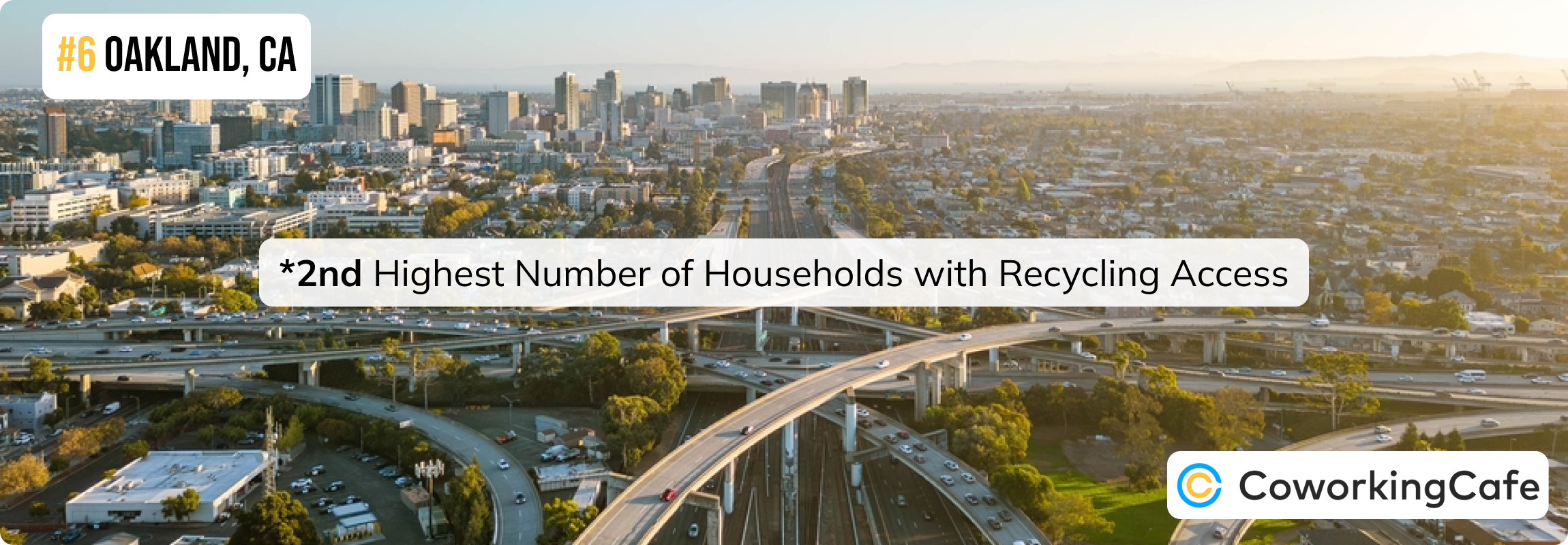 Oakland’s diverse environmental initiatives landed it in sixth place in our ranking of green cities. The California city excels in recycling, providing access to 95% of households, and maintains a strong recycling participation rate. What’s more, Oakland’s public transit system continues to reduce the city’s carbon footprint with a focus on electrifying buses and expanding bike lanes.
Oakland’s diverse environmental initiatives landed it in sixth place in our ranking of green cities. The California city excels in recycling, providing access to 95% of households, and maintains a strong recycling participation rate. What’s more, Oakland’s public transit system continues to reduce the city’s carbon footprint with a focus on electrifying buses and expanding bike lanes.
Despite being smaller than its Bay Area neighbor, San Francisco, Oakland is making significant headway with 161 green buildings and a commitment to preserving urban green spaces, thereby ensuring a healthier environment for its residents. Oakland’s local sustainability programs also emphasize urban farming and food security, further enhancing its green credentials.
7. New York City, NY– 51.8 points
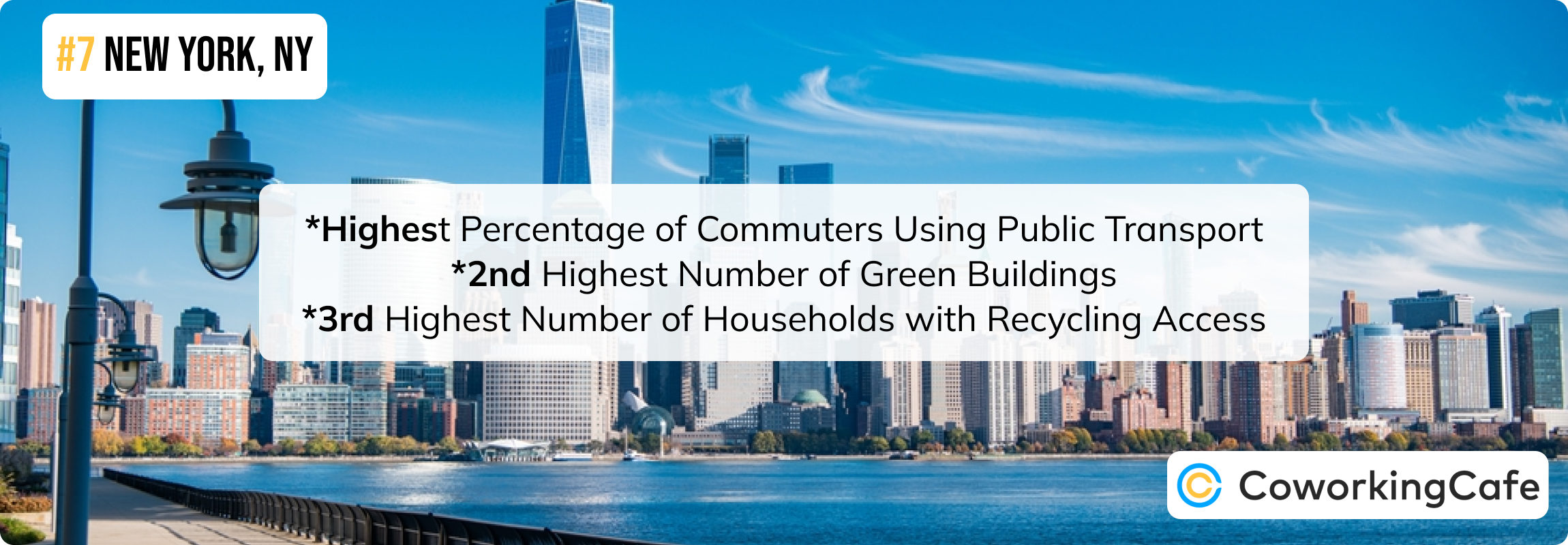 New York City ranks seventh, showcasing that even one of the densest urban areas in the world can prioritize sustainability. Of course, the city is a model for public transportation efficiency with nearly half of all commuters — 47.3% — using subways and buses. NYC has also embraced green building initiatives by hosting 1,068 LEED-certified structures, which is more than any other city on our list outside of Washington, D.C. Additionally, if your climate concerns expand beyond your home and into the workplace, NYC is the place to be: A total of 124 coworking spaces are available in green buildings. The Big Apple ranked first in this category.
New York City ranks seventh, showcasing that even one of the densest urban areas in the world can prioritize sustainability. Of course, the city is a model for public transportation efficiency with nearly half of all commuters — 47.3% — using subways and buses. NYC has also embraced green building initiatives by hosting 1,068 LEED-certified structures, which is more than any other city on our list outside of Washington, D.C. Additionally, if your climate concerns expand beyond your home and into the workplace, NYC is the place to be: A total of 124 coworking spaces are available in green buildings. The Big Apple ranked first in this category.
Not to be outdone, the city’s recycling programs reach 89% of households, and efforts are underway to boost participation rates even further. And, despite the low 4.5 acres per 1,000 residents, New York is actively working to expand green spaces by adding rooftop gardens and urban parks as part of its broader climate adaptation strategy. At the same time, the city’s continued investment in EV infrastructure (385 charging stations) indicates a strong push toward cleaner transportation solutions.
8. San Diego, CA – 51 points
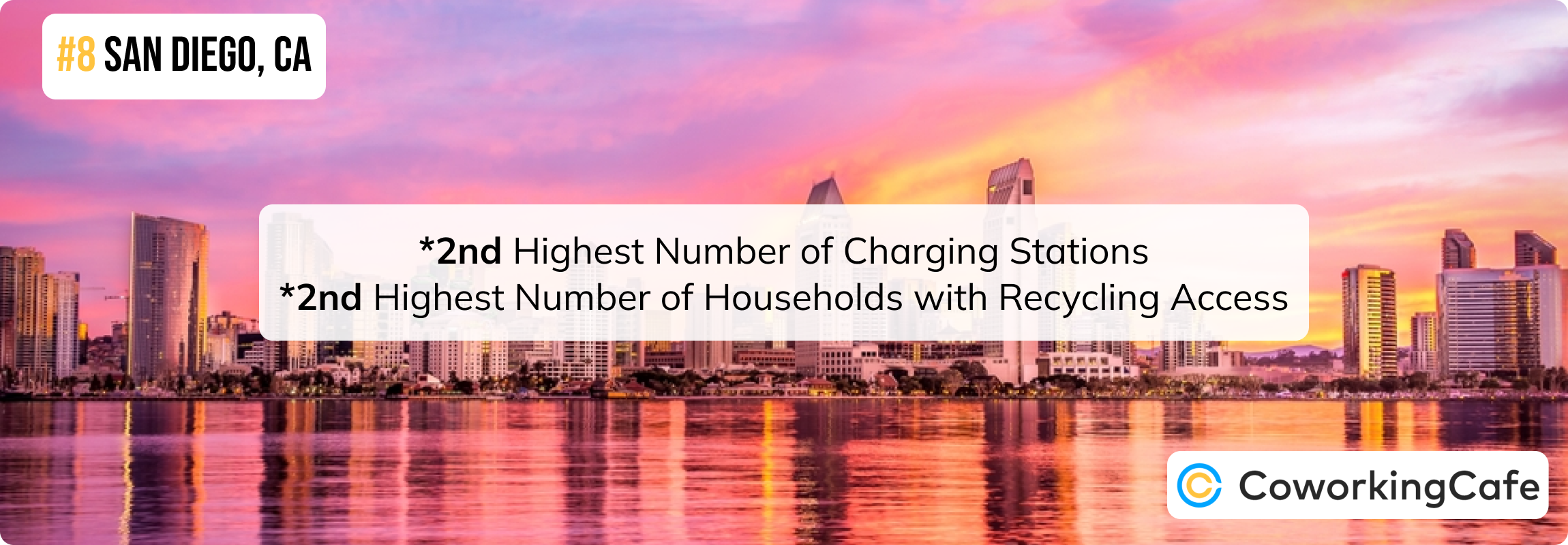 San Diego’s sunny weather isn’t just great for beachgoers. It’s also driving the city’s green energy agenda. Ranking eighth on our list, San Diego sources 54% of its energy from renewables. In particular, the city’s focus on EV adoption is visible through its 757 charging stations spread across the city.
San Diego’s sunny weather isn’t just great for beachgoers. It’s also driving the city’s green energy agenda. Ranking eighth on our list, San Diego sources 54% of its energy from renewables. In particular, the city’s focus on EV adoption is visible through its 757 charging stations spread across the city.
San Diego also excels in waste management with 95% of households having access to recycling services. Similarly, the city’s 532 green buildings, alongside initiatives to improve air quality (average AQI: 51), reflect a comprehensive approach to sustainability. San Diego’s strong emphasis on preserving coastal ecosystems and expanding urban green spaces also add additional layers to its environmental strategy.
9. Chicago, IL – 49.2 points
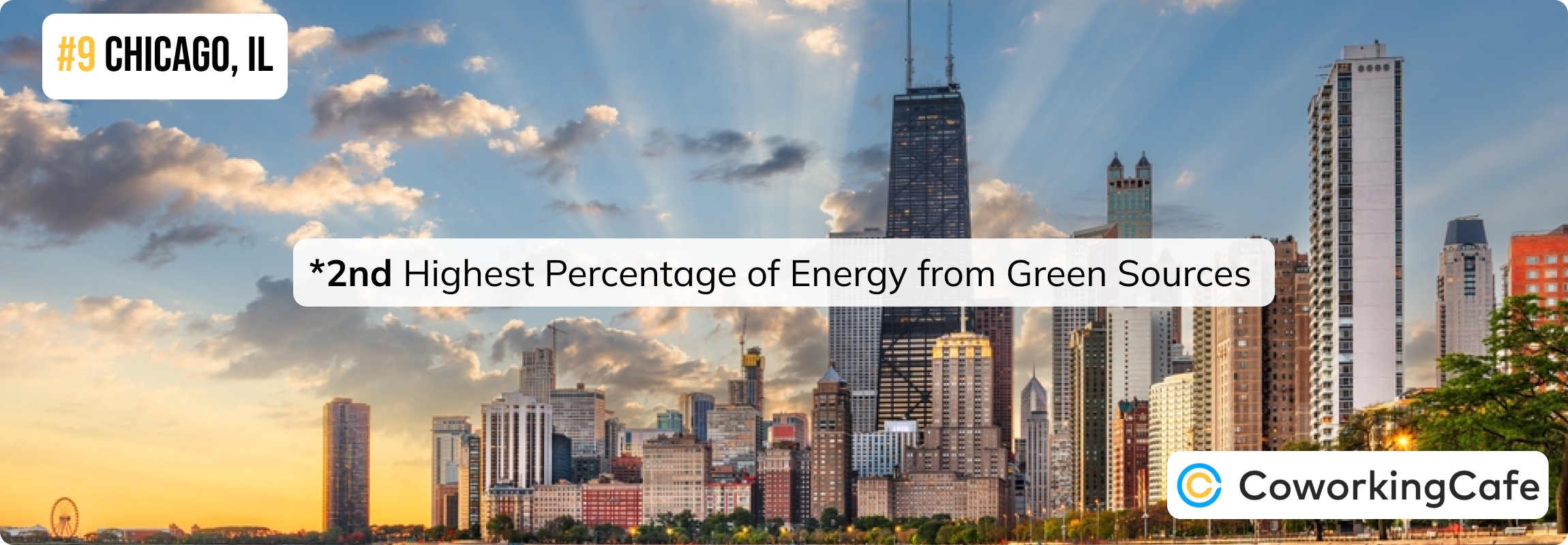 The Windy City ranked ninth, and Chicago’s green building boom is evident: The city has 986 sustainable structures driven by incentives for eco-friendly construction. Public transportation also remains a key aspect of Chicago’s environmental efforts with 21.2% of residents relying on buses and trains, which helps reduce car dependency and emissions.
The Windy City ranked ninth, and Chicago’s green building boom is evident: The city has 986 sustainable structures driven by incentives for eco-friendly construction. Public transportation also remains a key aspect of Chicago’s environmental efforts with 21.2% of residents relying on buses and trains, which helps reduce car dependency and emissions.
Although its average AQI of 67 indicates room for improvement, the city is making strides toward better air quality through targeted initiatives. Plus, Chicago’s robust recycling infrastructure covers 74% of households, and the city is exploring new ways to increase participation. Meanwhile, initiatives like the Chicago Climate Action Plan highlight the city’s long-term commitment to sustainability.
10. San Jose, CA – 47.1 points
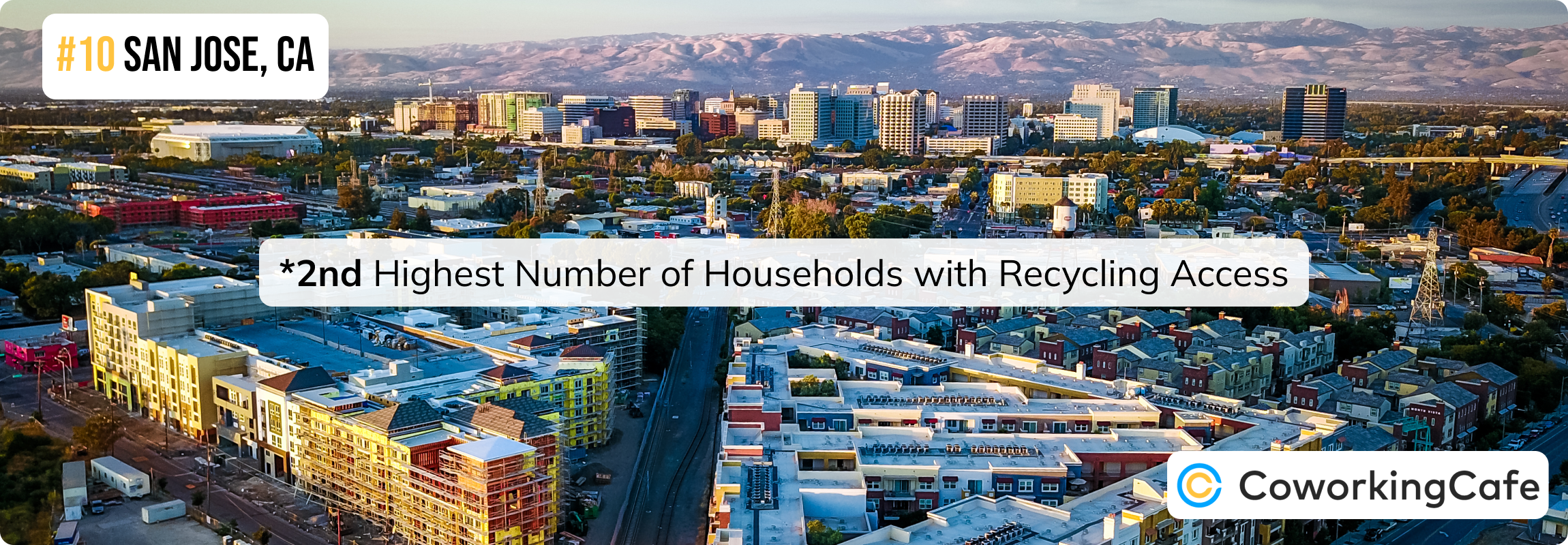 Rounding out the top 10, San Jose’s position is driven by a mix of high-tech innovation and environmental stewardship. For instance, San Jose is home to 575 EV charging stations, supporting the city’s high rate of electric vehicle ownership. Nearly all households (95%) have access to recycling services, and the city continues to push for higher participation in these programs.
Rounding out the top 10, San Jose’s position is driven by a mix of high-tech innovation and environmental stewardship. For instance, San Jose is home to 575 EV charging stations, supporting the city’s high rate of electric vehicle ownership. Nearly all households (95%) have access to recycling services, and the city continues to push for higher participation in these programs.
San Jose’s green energy utilization is particularly significant with 54% of power coming from renewable sources. Likewise, the city’s growing green building inventory of 235 structures complements its efforts in promoting energy efficiency and sustainable development. Of course, San Jose’s proximity to Silicon Valley also encourages innovation in environmental technologies, making it a city to watch in the green movement.
Next in Green: Cities Setting the Bar for Future Sustainability
Several cities are making significant strides in sustainability, making them the ones to watch for emerging green initiatives. First, Long Beach, CA, has positioned itself as a leader with broad recycling access; a strong commitment to renewable energy; and investments in green infrastructure, including 115 green buildings and 225 charging stations.
Staying in California, Sacramento is similarly advancing its green agenda, particularly in green building, where it has 235 certified structures, as well as more than 50% of its power coming from renewable sources.
Philadelphia, Boston and Denver are also driving noteworthy green efforts. Philadelphia, with 925 green buildings and nearly 20% of residents using public transportation, is reshaping its environmental landscape through its Greenworks program by focusing on energy efficiency and urban greening.
Its East Coast neighbor Boston stands out with its high public transit usage: 25.7% of residents rely on eco-friendly commuting options. Its commitment to climate resilience is also evidenced by investments in flood prevention and expanding green infrastructure.
Finally, although Denver faces challenges with air quality (as reflected by its AQI of 68), the city’s 992 green buildings and 353 charging stations signal promising progress in clean energy adoption and sustainable urban development.
Methodology
CoworkingCafe analyzed U.S. cities with at least 100,000 residents, considering only cities with complete datasets. Cities lacking full data for any metric were excluded. The final score was determined by comparing data points across cities with extreme values setting the upper and lower bounds for scoring.
Scoring Overview:
Commute Metrics (10 points total): Includes commute to work by bike (5 points) and public transportation (5 points) based on direct proportionality (higher values receive more points). [2022 Data – U.S. Census Bureau]
Transportation Infrastructure (20 points total): Bike/scooter share system (10 points) and percentage of green transportation (10 points) were evaluated based on the availability and usage of eco-friendly transportation options.
The bike/scooter share system metric is scored as follows:
- 0: Neither bike nor scooter share services are available.
- 1: Either bike or scooter share services are available, but not both.
- 2: Both bike and scooter share services are available.
[2023 Data – Bike League, APTA]
Environmental Quality (15 points total): Air Quality Index (5 points, with lower values scoring higher) and access to charging stations (10 points, favoring cities with more infrastructure) were assessed. [2023-2024 Data – EPA, AFDC]
Sustainable Energy & Recycling (30 points total): Green energy percentage (10 points) and recycling metrics, including access (10 points) and participation rates (10 points), were analyzed using state-level data. [2022-2024 Data – EIA, Recycling Partnership]
Green Spaces & Infrastructure (25 points total): Green spaces per 1,000 people (10 points), coworking spaces in green buildings (5 points), and overall green buildings (10 points) were also considered. [2024 Data – TPL, USGBC]
Data was sourced from the most recent available sets (2022-2024) with points distributed based on direct or inverse proportionality depending on the metric.
Fair Use & Redistribution
We encourage you to reuse, host, or repost the images in this article and freely grant permission to do so. We kindly ask that you attribute the authors by linking to CoworkingCafe.com or this page to allow your readers to learn more about this project, the research behind it and its methodology.

